Tags
animals, arrows, Athanasius Kircher, electromagnetism, Emperor, engravings, F. Valentini, Ferdinando IV, God, Greek, Hapsburg, hydraulics, Jesuit, lodestone, longitude, love, magnet, magnetism, Mars, Martin Martini, medicine, music, plants, rare books, Roman Catholic, symbol, tides, toys, universe, woodcuts, zodiac
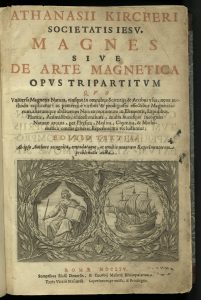
““The highest mountain, the oldest books, the strangest people, there you will find the stone.” — Attributed to Athanasius Kircher
Athanasii Kircheri Societatis Iesu Magnes; sive, de arte magnetica
Athanasius Kircher (1602-1680)
Romae: sumptibus Blasii Deuersin, & Zanobii Masotti Bibliopolarum typis Vitalis Mascarditypis V. Mascardi, MDCLIV (1654)
Third and final edition
QC751 K58 1654
Athanasius Kircher learned Greek and Hebrew at the Jesuit school in Fulda. He continued his scientific studies at Paderborn, Cologne, and Koblenz, taking orders in 1628 as a Jesuit priest. He traveled to Paris, fleeing fighting in Germany, and settled in Rome in 1634. His rigorous scientific curiosity was girded by a mystical conception of natural laws and forces. His methodology ranged from scholastic to hands-on experimentation. He once had himself lowered into the crater of Vesuvius to observe its features soon after an eruption. He was a prolific writer, publishing forty-four books. More than 2,000 of his manuscripts and letters survive. He assembled one of the first natural history collections, housed in a museum after his name in Rome, and later dispersed throughout various institutions.
The third edition of Magnes sive de arte magnetica is the first to appear in folio format. It is virtually a new work, rewritten and expanded from the first edition (1641). This edition is Athanasius Kircher’s largest, most complete, and definitive treatise on magnetism and electromagnetism (a term coined by Kircher in this work), which he conceived as a universal force of nature. Kircher compiled measurements of magnetic declination from several places around the world as reported by Jesuit scholars. One of these, Martin Martini, suggested to Kircher the possibility of determining longitudes by the declination of a magnetic needle, a possibility which Kircher then introduced to the scientific community.
In this work Kircher included discussions about the magnetism of the earth and heavenly bodies, the tides, the attraction and repulsion in animals and plants, and the magnetic attraction of music and love. He addressed the practical applications of magnetism in medicine, hydraulics, the construction of scientific instruments, and toys. Above it all, God remained the central magnet of the universe.
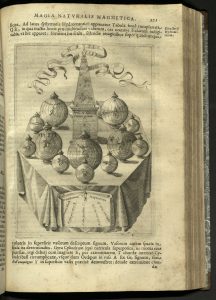
Glass spheres contain wax figures incorporating magnets, which can be affected by the large magnet in the base of the obelisk. On the globes are letters and signs of the Zodiac to which the figures point. By manipulating the handle in front of the table skirt, the operator could rotate the central magnet and cause the figures to answer questions or spell out words. The Greek inscription on the ribbon at the top of the obelisk is the Hermetic axiom, “Nature rejoices in Nature.” — p. 275
Illustrated with thirty-two full-page engraved plates and more than one hundred and fifty ornamental woodcuts throughout the text. Title-page printed in red and black. Rare Books copy has odd little hand-inked drawings by a past owner throughout.
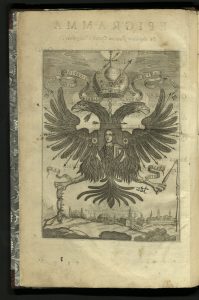
The portrait of Ferdinando IV, reigning Hapsburg Emperor, to whom Magnes sive de arte magnetica is dedicated, contains magnetic needles in the shape of arrows, a lodestone, the eye of God, the orb and cross corresponding to the ancient symbol for Mars, and other, even more esoteric, symbols. This engraving embodies the doctrine of Roman Catholic monarchy as a divine institution, and the emperor and his empire as the microcosmic reflections of God and his universe. Ferdinando IV died the year this edition was published, at the age of 21. — Engraving by F. Valentini
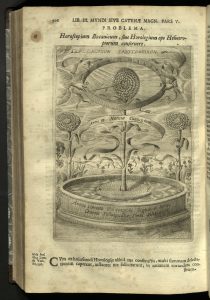
Sundial in the form of a sunflower — p. 508
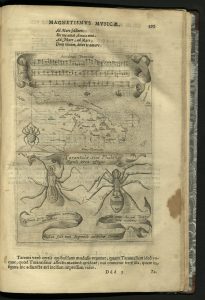
In southern Italy, most commonly in Apulia, dancing the Tarantella cured the tarantulla bite. — p. 593
Recommended reading:
Glassie, John. A Man of Misconceptions: The Life of an Eccentric in an Age of Change. New York: Riverhead Books, 2013
CT1098 K46 G53 2013, General Collection, L2

You must be logged in to post a comment.